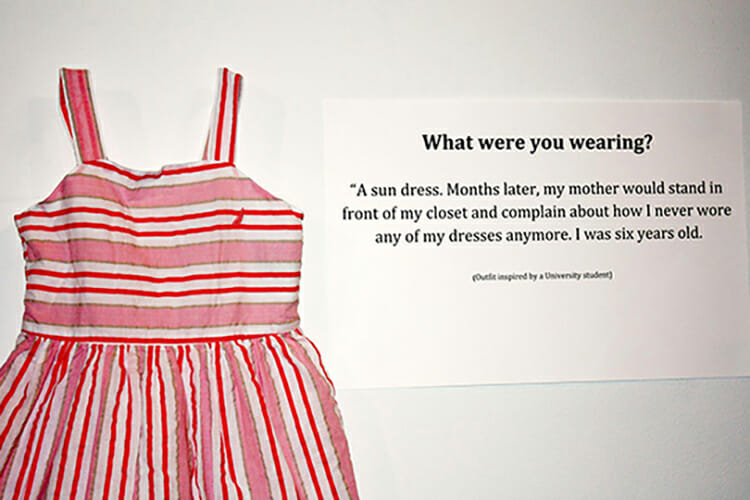It is a fairly well-known statistic that one in four women in the United States has experienced sexual assault. While that’s not a fun statistic or something that is easy to talk about, it is necessary to understand the gravity of this situation and how common it has become. Despite being something so terribly commonplace, there are still some who insist that it is the victim’s fault. This artifact’s purpose is to dispel those notions and bring light to how those who have suffered had no part in its instigation. This artifact is called the “What Were You Wearing” exhibit, and it has been done several times by different universities or women’s rights organizations. The name of the exhibit plays off a disturbingly common question sexual assault victims are asked, “what were you wearing?”, as some people believe that victims were wearing something to cause their assault. This exhibit displays how this crime can happen to anyone, regardless of who they are or what they look like. It uses an almost shock factor to get people to reconsider their preconceived notions about sexual assault, and shed light on what people have gone through. The exhibit uses the visuals of the clothes and the personal testimonies of victims to create a more personal connection to victims, as you learn about what they have gone through and how what they were wearing did not matter, viewers understand how their assault should be taken seriously and how asking a question like that could be more damaging. By seeing these faceless outfits, you separate the outfit from the person and can understand that the outfit had nothing to do with the crime, and instead, it was entirely the assaulter’s fault.



Your grabbber/hook is very thought-provoking and powerful, just as this whole topic is. I think it would have been helpful for you to bold the thesis in your introduction. Also, is there a reason that you pivoted and chose a whole new artifact for your essay rather than sticking with the one in your elevator pitch? I am just curious.
I didn’t feel that there was as much to analyze with my elevator pitch topic and that I would end up speaking in circles trying to get deeper into the meaning of the ad. I thought that there was a lot more here that I could analyze and speak about so I decided to switch.
This is a very impactful topic and very challenging to take on respectfully, so kudos to you for doing that. I think you are very specific with kairos and logos, but pathos is more implied. Just for the nature of the assignment, my only advice would be to be a little more specific on the impact on the audience, but aside from that, good job.
This is a strong choice in your artifact. I do think this artifact could be a little difficult to analyze because of the subject of sexual assault and making sure to carefully word as to not trigger anyone who may have dealt with it, but I also think it’s an important artifact to analyze as it challenges the misplaced blame on the victim and helps to challenge that idea. I think your hook did a really good job of setting the tone for the rest of the introduction.
I recognized this artifact even before you showed the photos, this is such an important and relevant artifact to talk about. I also think your thesis is really strong, genuinely I couldn’t find any criticisms. Really good work, and I can’t wait to see how you analyze this artifact.
This can be a hard topic to talk about but simultaneously very important. I think this new artifact is really strong and I felt immediate disgust from reading the “What were you wearing?” lines meaning the rhetoric is strong as well. I think your introduction is really strong and I look forward to how you approach this powerful artifact. Well done.